Yep, we moved back home to Montana in 2015!!! We’re in the Mission Valley, 45 miles north of Missoula. At the base of the beautiful Mission Mountains. On the Flathead Indian Reservation. We made it back home without being in a coffee pot like Shoni’s Uncle Pat.
Basic Hitching Information
The elements of hitching are twisting ten or eleven horse tail hairs together into a pull. The pulls are knotted over nylon string which is wound around a dowel. You are working with a tube when hitching. This tube is pressed flat after hitching is done (remove the dowel). For reins, the hitching is done over rope, and the rope left inside. Only two knots are used to create all the intricate patterns.
Note that hitched horsehair is NOT the same as braided horsehair. Hitched horsehair is a series of knots; while braiding is – think like a girl’s hair is braided. Hitched horsehair will last for generations. Braiding does not have the same lasting stability.
Receive autographed books on retail orders!
Ordering information is at the bottom of the page.
Hitched Horsehair: The Complete Guide for Self-Learning, by Shoni Maulding, ©1997
This book gives the beginner everything necessary to learn how to hitch. Twist pulls. Then move onto making the two knots used in hitching which create all the intricate designs. Drop and add pulls.
The 6 row diamond is your first geometric to learn. It is the basis for all geometric designs. The cross hitch border frames hitching in like a picture border, and this technique is described.
Learn how to dye horsehair pulls. Make a press to flatten your hitched tube. Traditional needle knots used to cover joints are described.
After learning how to hitch, the most important chapter is the graph paper chapter. Learn how to create your own designs, and project layout.
We do not leave you high and dry – take your hitched blank into finished projects. Making leather belt ends, finishing belts, key fobs, hatbands, and reins is included. Directions for headstalls are not included, but if you can make a hatband, you can make a headstall. Headstalls are just a grouping of hitched pieces attached to each other and/or leather.
This first book contains 14 graphed patterns with complete directions.
186 pages, 8 1/2ʺ x 11ʺ, Softcover, Illustrated, 4 page color insert, Supplier List.
Price is $29.99, plus shipping. See below for shipping charges and how to order.
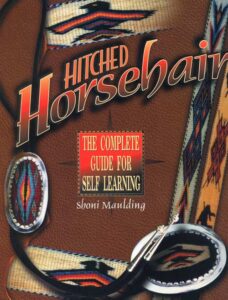
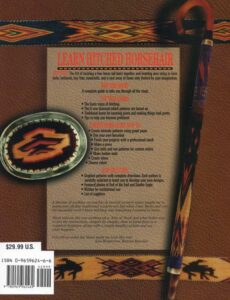
Hitched Horsehair II: Advanced Patterns and Inlay Projects
By Shoni and Ron Maulding, ©2004
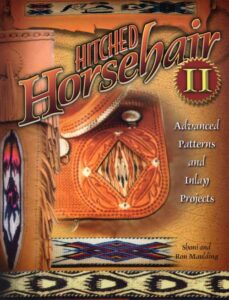
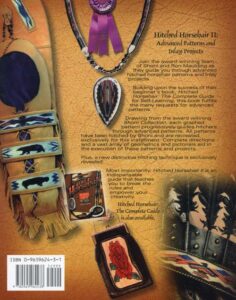
Building on the success of their beginner’s book, this book fulfills the many requests for advanced patterns. Drawing from the award-winning Shoni Collection, each graphed pattern guides hitchers through over 30 advanced patterns with complete directions. Patterns include eagle, buffalo, bear, blue pony, rose in feather, End of the Trail, alphabet and numbers, geometrics, etc. Pictorial patterns are generally harder to design and hitch than geometrics. You must know how to hitch to use the patterns.
If you want to put hitched inlays in leather, this is the book for you. It explains how to design inlays for length and width so you have the inlay size you need. Inlay shrinkage makes a difference with size, as do other factors. Learn how to work with these factors.
Projects with hitched inlays in leather include a buckle, belt, barrette, pin, checkbook cover, notepad, purse, capelet, Indian cradleboard, and quiver. Lisa Skyhorse, master saddlemaker and leatherworker, contributed the section on inlays in saddles.
A new technique of hitching patterns is also explained. You will be surprised how easy this is. It’s great for making your pictorial designs look the way they are graphed.
240 pages, 8 1//2ʺ x 11ʺ, softcover, illustrated, 4 page color insert, Supplier List
Price is $29.99, plus shipping. See below for ordering information and shipping charges.
To order directly from us within the United States, please send a check or money order. Make it out to Hitching Tails; and mail to PO Box 653, Saint Ignatius, MT 59865. Price of each book is $29.99, plus $7.95 priority mail shipping for a total of $37.94.
For all credit card orders within the United States and internationally, we are referring you to Hitching Post Supply. Website is: www.hitchingpostsupply.com. Phone # 1-800-689-9971 or 541-495-1916. Email is: jess@hitchingpostsupply.com. Address: 53755 Anderson Valley Road, Princeton, OR 97721. You can order directly from their website.
Wholesale prices available. Please inquire.
Prices subject to change.
First Projects to Learn with Hitched Horsehair
Key Fob First Project
 This key fob is a great first project. Tie on various colored pulls to see how the open hitch knot and closed hitch knot look. The open hitch knot swirls away from you.
This key fob is a great first project. Tie on various colored pulls to see how the open hitch knot and closed hitch knot look. The open hitch knot swirls away from you.
The closed hitch knot swirls towards you. Straight lines are created by hitching all one row of open hitch knots; then all one row of closed hitch knots. Alternate the rows for the straight look, used in belts, hatbands, etc., where you do not want swirl.
This key fob is hitched in Day 1 of the 3 day workshop.
6 Row Diamond
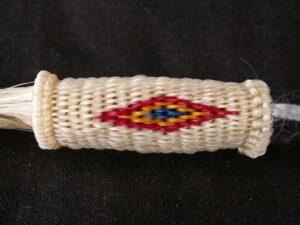 The 6 row diamond is the basis for all geometric patterns. At the apex, there are six pulls across the row, which is where its name comes from. It takes 13 rows to hitch. For a beginner, hitch with a white background as the pulls are easier to see to grab. In Day 2 of the 3 day workshop, the student hitches the 6 row diamond, with the addition of the cross hitch border. Cross hitch border is not shown in this photo.
The 6 row diamond is the basis for all geometric patterns. At the apex, there are six pulls across the row, which is where its name comes from. It takes 13 rows to hitch. For a beginner, hitch with a white background as the pulls are easier to see to grab. In Day 2 of the 3 day workshop, the student hitches the 6 row diamond, with the addition of the cross hitch border. Cross hitch border is not shown in this photo.
Who hitches horsehair?
Our workshop students have included: veterinarians, hair dresser, demolition deep sea diver, avocado farmer, Harley biker, opera singer, nuclear power plant radiation test screener, nurse, TV camerawoman, wine taster/martial artist, accountant, caregivers, retired rancher, welding consultant for oil companies. Sam Henderson was 76 years old when he learned how to hitch from the rough draft of our first book. This just lists a few.
One of our workshop students has taught hitched horsehair to high school students in their art class. Some of these students used hitched horsehair for their senior project, a requirement for graduation. His students like it and hate it for the same reasons: challenging, not simple, hard and time consuming, complicated, rewarding.
Leaders of 4-H are teaching it, using our books. One college student wrote a how-to booklet for her creative writing class. The Europeans have taken it on big time. Today there are more people hitching than ever before, on a world-wide basis. Our books have sold in 23 countries that we know of.
Technical Advisers
From 2012 through 2015, we were technical advisers for the book, Horsehair Bridles: A Unique American Folk Art, by Ned and Jody Martin. It was published in 2016.